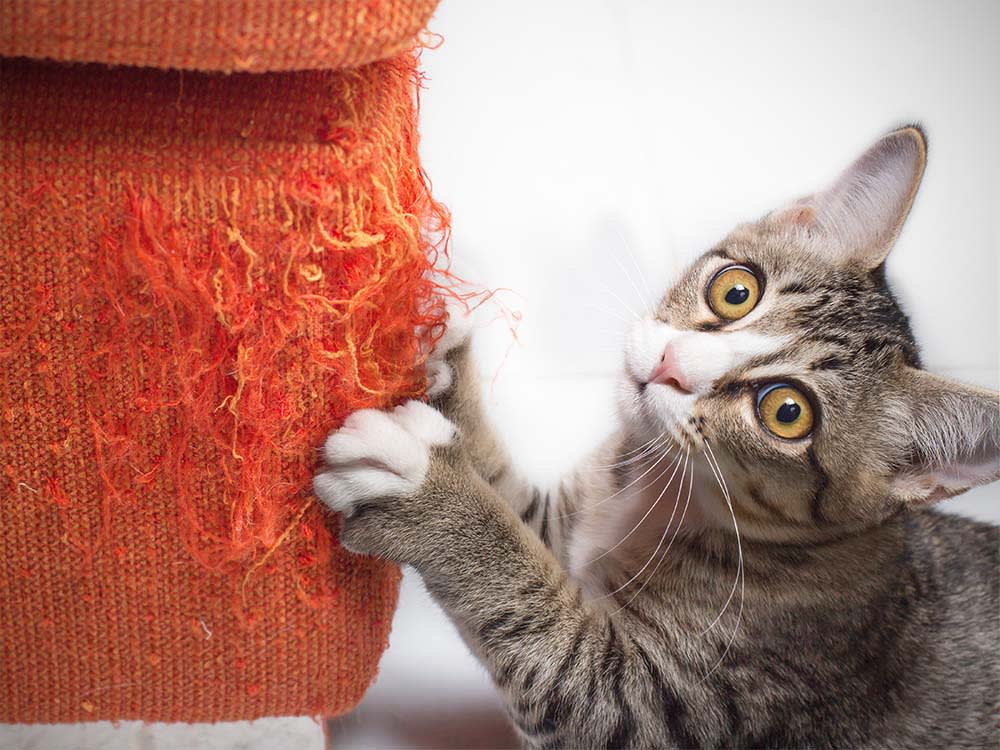Scratching is a natural and instinctive behavior for cats, when this behavior is directed at your furniture, it can become a source of frustration.
In this guide, we’ll explore the reasons behind this common feline habit, identify effective strategies to redirect your cat’s scratching, and offer practical tips to protect your furniture while keeping your cat happy and healthy.
|
Table of Content: 1. Understanding Why Cats Scratch Furniture? 2. How to redirect destructive scratching behavior? 3. Frequently asked questions 4. Conclusion |
Understanding Why Cats Scratch Furniture?
1) Marking Territory: Cats use scratching to mark their territory with scent glands located in their paws.
2) Claw Maintenance: Scratching helps cats keep their claws sharp and remove old layers of claw sheaths.
3) Stretching Muscles: The action of scratching allows cats to stretch their muscles, particularly in their front legs and back.
4) Stress and Anxiety Relief: Scratching can be a coping mechanism for cats experiencing stress or anxiety.
5) Boredom or Lack of Stimulation: Cats may scratch furniture if they are bored or not getting enough mental or physical stimulation.
6) Natural Instinct: Scratching is an instinctive behavior rooted in their wild ancestors, necessary for their overall well-being. Check out some interactive toys. HERE.

How to redirect destructive scratching behavior?
1) Provide Scratching Posts:
Offer a variety of Scratchers and Poles made from different materials like sisal, cardboard, or carpet to attract your cat.
2) Place Scratching Posts Strategically:
Position scratching posts near the furniture your cat tends to scratch or in high-traffic areas where your cat spends time.
3) Apply Deterrents:
Use furniture covers, double-sided tape, or commercial deterrent sprays on your furniture to make scratching less appealing. One of the recommended Sprays is Beaphar’s indoor behavior spray.
4) Trim your Cat's nails regularly:
Regular nail trimming can help reduce the damage caused by scratching and minimize the urge to scratch. Furrish’s nail chipper can make trimming your job easy.
5) Encourage Scratching with Positive Reinforcement:
Reward your cat with treats and praise when they use the scratching posts or designated areas.
6) Provide Environmental Enrichment:
Offer interactive toys and activities to keep your cat stimulated and reduce boredom-related scratching. Check out Cat Trees and many more amazing interactive toys for your ball of fur.
7) Redirect Scratching:
Gently redirect your cat to the scratching posts when you catch them scratching furniture, and encourage them to use the alternatives.

Frequently Asked Questions:
1) What types of scratching posts are best for cats?
Scratching posts made from sisal, cardboard, or carpet are effective. Choose a variety of heights and textures to find what your cat prefers.
2) How do I choose the right scratching post for my cat?
Observe your cat’s scratching preferences and choose a post that matches their preferred material and height. Ensure it’s sturdy and well-placed.
3) How often should I trim my cat’s claws?
Regularly trim your cat’s claws every 1-2 weeks or as needed, depending on their growth rate and scratching behavior.
4) What can I use to deter my cat from scratching furniture?
Use double-sided tape, commercial deterrent sprays, or protective covers on furniture to make scratching less appealing. You can also use aluminum foil or a rubber mat as a deterrent.
5) Is it okay to punish my cat for scratching furniture?
No, punishment is not effective and can harm your bond with your cat. Instead, use positive reinforcement to encourage them to use appropriate scratching areas.
6) How can I redirect my cat’s scratching behavior?
Gently guide your cat to scratching posts when you catch them scratching furniture. Reward them with treats and praise when they use the scratching post.
7) Will providing a scratching post stop my cat from scratching furniture?
Providing a scratching post is an important step, but it’s also essential to use deterrents on furniture and address any underlying stress or boredom.
8) Can scratching furniture be a sign of a behavioral problem?
While scratching is usually normal, excessive scratching or changes in behavior could indicate stress, boredom, or other issues. If concerned, consult a veterinarian or animal behaviorist.

Conclusion
Cats scratch furniture as a natural behavior for marking territory, maintaining claws, and stretching muscles. To manage this, provide appealing scratching posts, use deterrents, and reward your cat for using the right areas. Regular claw trimming and environmental enrichment can also help reduce unwanted scratching. With patience and the right strategies, you can protect your furniture and ensure your cat remains happy and healthy.






